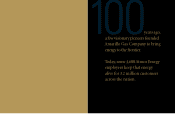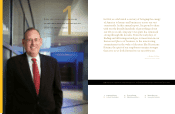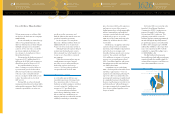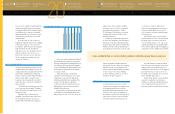Atmos Energy 2006 Annual Report Download - page 10
Download and view the complete annual report
Please find page 10 of the 2006 Atmos Energy annual report below. You can navigate through the pages in the report by either clicking on the pages listed below, or by using the keyword search tool below to find specific information within the annual report.
Baby Jessica McClure was
rescued from an abandoned
well pipe with the help of
our employees 19 years ago.
Because natural gas is one of
the most efficient energy
sources, its use has increased
35 percent during the past
decade and demand
is expected to grow by
40 percent by 2025.
19
35
16
–
17
to write off our irrigation properties
in West Texas. The volumes of natural gas
we deliver for irrigation pumping in
Texas have continued to decline year after
year and were not expected to generate
enough cash flow from operations to
recover our net investment.
On the positive side, our biggest
financial success came in breakthroughs
in rate design in our utility segment.
These changes should help return our
utility to strong performance in fiscal
2007 and beyond.
We secured protection from weather
in our two largest divisions. In Texas, the
Railroad Commission granted our
Mid-Tex Division a weather normalization
adjustment as part of a pending rate case.
In Louisiana, the Public Service
Commission allowed new rate provisions
that protect our margins from warm
winter weather, declining customer use
and greater conservation.
wellhead sales revenues, severance taxes,
property taxes and royalty-owner
revenues. Atmos Energy and our minority
partner, Kinzer Drilling Company,
plan to invest between $75 million and
$80 million in the project.
N E W R A T E D E S I G N S H O U L D H E L P U T I L I T Y S E G M E N T
Extremely volatile natural gas prices, one
of the warmest winters on record and
two of the worst hurricanes in American
history strained our utility business
by adding operating costs and lowering
utility revenues.
In particular, unseasonably warm
winter weather, which was 13 percent
warmer than normal, reduced our utility
earnings. Net income from utility
operations fell to $53.0 million from $81.1
million in fiscal 2005. In addition,
we lost approximately 230,000 utility
customers in Louisiana until service
could be restored after Hurricanes Katrina
and Rita. About 26,500 of these customers
became permanent losses with no plans
for rebuilding homes or businesses.
Utility earnings also were reduced by
a nonrecurring after-tax charge of
$14.6 million, or 18 cents per diluted share,
As a result of these changes, more
than 90 percent of our customer margins
are now substantially insulated from
the effects of adverse weather. This has
been a primary goal to help safeguard
our earnings.
We cannot control the weather and
we cannot control the cost of natural
gas; however, we can control how we
address adverse situations. We believe
that implementing sound rate-design
principles benefits both the company
and our customers over the long term.
K E E P I N G R A T E S C U R R E N T
We filed a number of rate cases during
2006, seeking rate increases and weather
normalization adjustments as well as
provisions to compensate for declining
customer use and to recoup our costs
for the natural gas consumed by customers
with uncollectible accounts.
In Louisiana, the Public Service
Commission acted quickly to allow a rate
increase, subject to refund, of $10.8 million.
The increase covered customer losses in
Katrina-affected parishes and increases in
rate base and operating expenses.
Our most significant rate filing was
for a $60 million increase in Texas by our
Mid-Tex Division to recover increases
in the division’s operating costs and its
allowed rate of return. A decision is due
no later than April 2007.
In Texas, we also continued to refresh
our rates under the state’s Gas Reliability
Infrastructure Program, or GRIP. The
program authorizes utilities to earn a rate
of return on their incremental annual
capital investments. It also reduces the
regulatory lag time between when we
make an investment and when we begin
earning a return on it.
Since 2003, we have been able to
increase base rates in Texas under GRIP
by about $190 million while earning
about $36 million in allowed return on
that investment.
In Missouri, we reached a tentative
settlement in a rate case seeking an
69
We cannot control the weather and we cannot control the cost of natural gas;
however, we can control how we address adverse situations.
In 1859, Edwin Drake drilled
the first commercial well
and hit oil and natural gas at
69 feet below the surface of the
earth. A two-inch-diameter
pipeline was built, running
5.5 miles from the well to the
village of Titusville,
Pennsylvania. This discovery
well is considered to be
the beginning of the natural
gas industry in America.
. . . . . the acquisition of Western Kentucky Gas. 1988: Energas changed its name to Atmos Energy Corporation and was listed on the NYSE (ATO). 1993: Atmos . . . . . . . . . . . . . . . . . . Energy acquired Greeley Gas operations in Colorado and Kansas. 1997: Atmos Energy doubled in size to one million customers through its merger with . . . . . . . . .
E A R N I N G S R E V I E W
$ 2 .0 0
1.60
1. 20
.8 0
.4 0
0
2 0 0 2 2 0 0 3 2 0 0 4 2 0 0 5 2 0 0 6
Net income per diluted share
$1.45
$1.54
$1.58
$1.72
$1.82





















